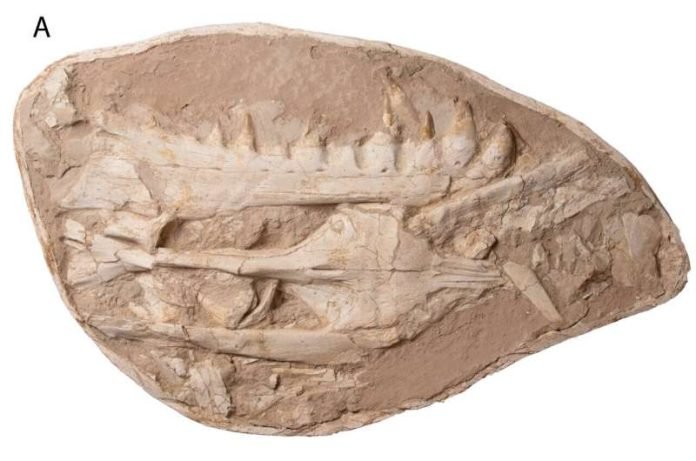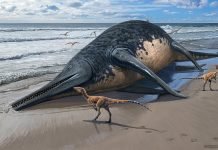
In a recent discovery, paleontologists have unveiled a new species of marine lizard that roamed the oceans around 66 million years ago, during the twilight of the dinosaurs.
Named Khinjaria acuta, this creature belonged to the family of mosasaurs, not dinosaurs, but formidable marine predators akin to the modern Komodo dragon and anacondas.
Unlike today’s oceans, where a few apex predators like great white sharks, orcas, and leopard seals rule the top of the food chain, the ancient seas were home to a plethora of giant predators, all vying for dominance in a much more competitive and diverse ecosystem.
The research, detailed in the journal Cretaceous Research, showcases the fascinating diversity of prehistoric marine life based on fossils recovered from a phosphate mine near Casablanca, Morocco.
This collaborative effort involved scientists from the University of Bath in the UK, the Marrakech Museum of Natural History, the Museum National d’Histoire Naturelle in Paris, Southern Methodist University in Texas, and the University of the Basque Country in Bilbao.
Khinjaria acuta’s defining features were its powerful jaws and long, dagger-like teeth, adapted for seizing large prey, painting a picture of an ocean filled with nightmarish predators.
This mosasaur’s discovery sheds light on a time when the Atlantic Ocean, off the coast of Morocco, teemed with an extraordinary array of large, top-tier predators, each employing different hunting strategies suggested by their varied teeth shapes and sizes.
Dr. Nick Longrich from the University of Bath, who led the study, emphasized the unprecedented diversity of these marine predators.
From teeth designed to pierce, cut, tear, or crush, to Khinjaria’s intimidating dagger-shaped teeth, the Late Cretaceous period boasted one of the most varied marine faunas in history.
This period of remarkable biodiversity came to an abrupt end with the asteroid impact that struck the Yucatan Peninsula, leading to a mass extinction event that reshaped life on Earth and in the seas.
The catastrophic event wiped out dinosaurs on land and the dominant marine reptiles like mosasaurs and plesiosaurs, paving the way for mammals, birds, and lizards to diversify and fill the vacated ecological niches.
Similarly, in the oceans, the extinction of these ancient marine reptiles and other species made room for the evolution of whales, seals, and a new array of fish, including swordfish and tuna.
The study not only highlights the extraordinary diversity of predators in the Late Cretaceous seas but also points to a significant shift in the marine ecosystem over the past 66 million years.
Today’s marine food chains are structured very differently, with fewer large predators that mainly consume smaller prey. The reasons behind this dramatic change in the ecosystem, whether due to the types of marine reptiles, their prey, or environmental factors, remain a subject of fascination and ongoing research.
The phosphates of Morocco, providing a wealth of fossil evidence from this pivotal period, offer invaluable insights into the ancient marine ecosystems and their inhabitants.
As scientists continue to unearth and study these fossils, they unravel the mysteries of a world that once was, shedding light on the evolution of life on our planet and the dynamic changes that have shaped it over millions of years.
The research findings can be found in Cretaceous Research.
Copyright © 2024 Knowridge Science Report. All rights reserved.




